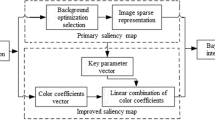Abstract
As we all know that image saliency estimation is an important technique in many computer vision applications. We study bottom-up saliency estimation method based on sparse representation and structural redundancy reduction. Firstly, we learn a set of basis functions using independent component analysis on a large set of natural images and obtain image sparse coefficients. Secondly, we compute the Shannon entropy of the image sparse coefficients to represent its pixels information which build up the image information map. Finally, we discard the structural redundancy of the information map to yield the image saliency map. The performance of the proposed model is studied on natural scenes and psychophysical patterns, and evaluated with ground-truth data. The evaluation proves that the proposed model is highly consistent with the subjective visual attention.











Similar content being viewed by others
References
Achanta R, Hemami S, Estrada F et al (2009) Frequency-tuned saliency region detection. IEEE Conference on Computer Vision and Pattern Recognition, Miami, Florida, pp 1597–1604
Bruce NDB, Tsotsos JK (2009) Saliency, attention, and visual search: An information theoretic approach. J Vis 9(3):1–24
Buades A, Coll B, Morel J et al (2005) A non-local algorithm for image denoising. IEEE Computer Society Conference on Computer Vision and Pattern Recognition (CVPR) 2:60–65
Fang Y, Chen Z, Lin W (2012) Saliency Detection in the compressed domain for adaptive image retargeting. IEEE Trans Image Process 20(9):3888–3901
Fang M, Kuan Y, Kuo C et al (2012) Effective image retrieval techniques based on novel salient region segmentation and relevance feedback. Multimed Tools Appl 57(3):501–525
Fang Y, Liu W, Lee BS et al (2012) Bottom-up saliency detection model based on human visual sensitivity and amplitude spectrum. IEEE Transactions on Multimedia 14(1):187–198
Fawcett T (2006) An introduction to ROC analysis. Pattern Recogn Lett 27:861–874
Gao Z, Liu A, Zhang H, et al. (2012) Human action recognition based on sparse representation induced by L1/L2 regulations, 21st International conference on pattern recognition (ICPR 2102): 1868–1871
Guo C, Ma Q, Zhang L (2008) Spatio-temporal saliency detection using phase spectrum of quaternion Fourier transform, IEEE Conference on Computer Vision and Pattern Recogniton (CVPR): 1–8
Harel J, Koch C, Peerona P (2006) Graph-based visual saliency. NIPS: 545–552
Hateren JH, Schaaf A (1998) Independent component filters of natural images compared with simple cells in primary visual cortex. The Royal Society of London Series B-Biological Sciences 265(1394):359–366
He S, Han J, Hu X et al. (2011) A biologically inspired computational model for image saliency detection, 19th ACM international conference on Multimedia: 1465–1468
He D, Liu S, Liang X et al (2011) Improved saliency toolbox/Itti model for region of interest extraction. Opt Eng 50(9):097202
Hou X, Zhang L (2007) Saliency detection: A spectral residual approach, IEEE Conference on Computer Vision and Pattern Recognition (CVPR):1–8
Hyvärinen A, Oja E (2000) Independent component analysis: Algorithms and applications. Neural Netw 13(4–5):411–430
Itti L, Koch C, Niebur E (1998) A model of saliency-based visual attention for rapid scene analysis. IEEE Tranctions on Pattern Analysis and Machine Intelligency 20(11):1254–1259
Koch C, Ullman S (1985) Shifts in selective visual attention: towards the underlying neural circuitry. Hum Neurobiol 4:219–227
Lang C, Liu G, Yu J et al (2012) Saliency detection by Multitask Sparsity Pursuit. IEEE Trans Image Process 21(3):1327–1338
Lee JS, Simone FD, Ebrahimi T (2011) Efficient video coding based on audio-visual focus of attention. Visual Communication and Image Representation 22(8):704–711
Liang Z, Chi Z, Fu H et al (2012) Salient object detection using content-sensitive hypergraph representation and partitioning. Pattern Recogn 45:3886–3901
Liang Z, Wang M, Zhou X et al (2012) Salient object detection based on regions. Multimed Tools Appl. doi:10.1007/s11042-012-1040-1
Liu Q, Han T, Sun Y et al (2012) A two step salient objects extraction framework based on image segmentation and saliency detection. Multimed Tools Appl. doi:10.1007/s11042-012-1077-1
Liu H, Heynderickx I (2011) Visual attention in objective image quality assessment: Based on Eye-Tracking data. IEEE Transactions on Circuits and Systems for Video Technology 21(7):971–982
Liu T, Sun J, Zheng N et al (2007) Learning to detect a salient object. IEEE Conference on Computer Vision and, Pattern Recognition (CVPR), pp 1–8
Ma Y, Zhang H (2003) Contrast-based image attention analysis by using fuzzy growing, ACM International Conference on Multimedia: 374–381
Olshausen B (1996) Emergency of simple-cell receptive field properties by learning a sparse code for natural images. Nature 381(6583):607–609
Sun X, Yao H, Ji R, et al. (2010) Saliency detection based on short-term sparse representation, IEEE 17th International Conference on Image Processing: 1101–1104
Treisman AM, Gelade G (1980) A feature-integration theory of attention. Cogn Psychol 12(1):97–136
Wang M, Li j, Huang T, et al. (2010) Saliency detection based on 2D Log-Gabor wavelets and center bias, 18th ACM International Conference on Multimedia: 979–982
Wu J, Qi F, Shi G et al (2012) Non-local spatial redundancy reduction for bottom-up saliency estimation. Visual Communication and Image Representation 23(7):1158–1166
Zhang H, Tian X, Chen Y (2011) Video image assessment with a distortion-weighing spatiotemporal visual attention model. Multimed Tools Appl 52:221–233
Zhu K, Saupe D (2013) Performance evaluation of HD camcorders: measuring texture distortions using Gabor filters and spatio-velocity CSF, Image Quality and System Performance X, 8653(9): 86530A
Acknowledgment
This research is supported by National Nature Science Foundation of China (Grant No: 60975007) and National High Technology Research and Development Program of China (“863” Program) (Grant No. 2013AA10230402). We would like to thank Ming-Ming Chen for providing the saliency maps of the state-of-the-art approaches for result comparison.
Author information
Authors and Affiliations
Corresponding author
Rights and permissions
About this article
Cite this article
Long, Y., He, D. & Song, H. Bottom-up saliency estimation using sparse representation and structural redundancy reduction. Multimed Tools Appl 74, 9647–9663 (2015). https://doi.org/10.1007/s11042-014-2144-6
Received:
Revised:
Accepted:
Published:
Issue Date:
DOI: https://doi.org/10.1007/s11042-014-2144-6




